How to graft a pear to an apple tree?

Pears and apple trees are related plants whose yield can be increased by grafting. Thus, one tree can produce 2 times more fruits. This saves space in the garden.
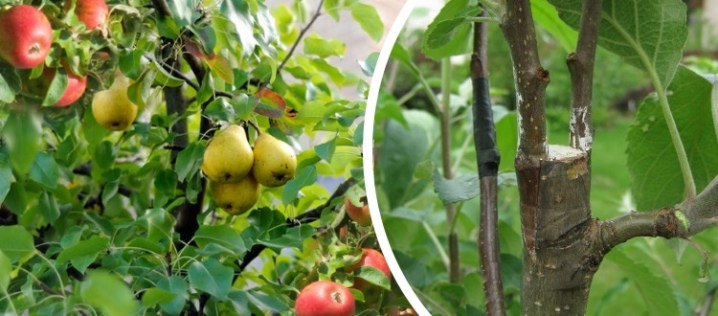
Features of vaccination
The apple tree and the pear are perfectly crossed with each other. With a little effort, you can get fruit that tastes better. Practice shows that grafting results in fruits that are different in flavor and appearance. Also, many experimenters note that the volume of crops after grafting increases.
Most often, crossing two fruit trees is chosen for the following reasons.
- In order to get a fruit platter with an original taste. This makes it possible to make the assortment of fruits more varied.
- To activate the powers of a weaker tree. By damaging the bark on an apple tree, you can make it produce a more bountiful harvest.
- Grafting strengthens the plant's immunity. Through crossbreeding, internal resources are activated and crops become more resistant to disease.
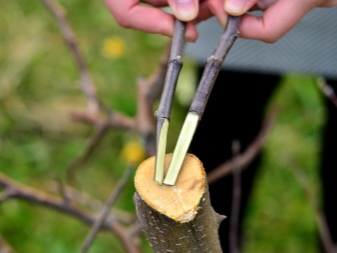
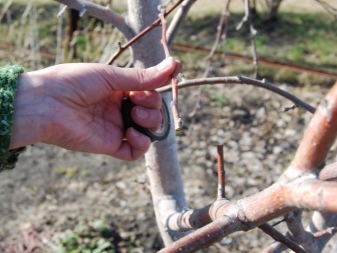
Timing
Crossing a pear with an apple tree can be carried out in the spring. This period is the most optimal for this procedure. In the spring months, the sap begins to actively move along the tree trunk, so close crops take root better. However, it is important to find good weather conditions. So, the temperature should not be below zero at night and ten degrees Celsius during the day. You can determine whether the trees are ready for grafting by actively swelling buds on the branches. This happens most often in April. Spring vaccination is especially convenient because if it fails, it can be repeated after a couple of months.
In summer, crossing is done most often in July or August. In hot weather, a second period can be observed when the plants revive. At this time, the active movement of the juice along the branches begins, and the bark becomes softer and more elastic.
Summer grafting is also convenient in that you do not need to prepare the scion in advance. However, it is necessary to choose the right time of work (in the morning or evening hours) so that the sun does not harm the fresh cuttings.
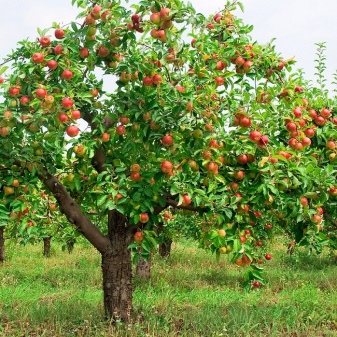
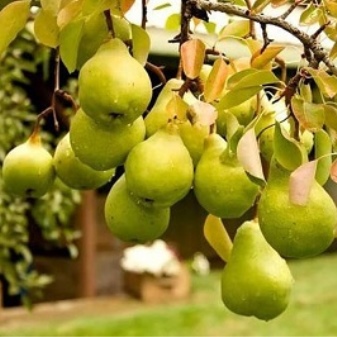
During this period, it is best to work with young plants. It is important to have time to cross before the tree begins to bear fruit. If the formation of fruits has already begun, then you should wait for the harvest. It is worth noting that in the Urals, it is summer that will be the best time for vaccination. In autumn, crossing is recommended until mid-September. This is due to the fact that the weather is unstable during the autumn months.
Most experienced gardeners consider this period unsuccessful for grafting, since the lesions on the rootstock will heal at a slow rate. Also, the graft site can be frozen after a cold winter, resulting in failure. Therefore, it is best to graft the pear to the apple tree during the spring and summer months. However, practice has shown that it is possible to carry out a successful crossing even in winter. In this case, grafting on the bark is not carried out. For a good result, you should adhere to a number of rules:
- as a scion, you need to choose pear cuttings that are cold-hardened;
- the stock should be annual apple seedlings or wild root;
- after grafting, the plant must be stored in a cool place until spring;
- when the soil warms up, the grafted tree must be planted in the ground.
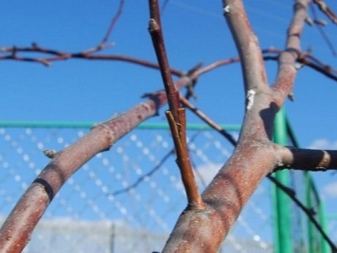
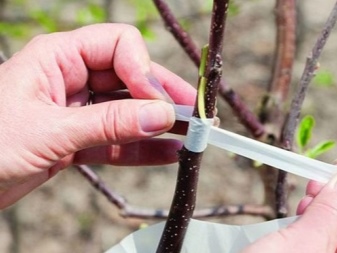
Basic methods
Grafting a pear to an apple tree is not difficult at all. For beginners, there are many instructions that describe in detail one or another method of crossing. The simplest of these is the use of a grafting secateurs. It is convenient for having interchangeable profiles that allow you to make incisions for grafting in different planes. When using such a tool, adjustment is not required, since the cuts on both the scion and the rootstock will exactly match. As a result, the woody and cambial layers are completely combined.
In this easy way, you can do several vaccinations at the same time. However, it must be borne in mind that a special pruner limits the choice of grafting material in thickness. Among the disadvantages, it is also worth noting the clogging of the cut planes, which complicates the accretion of the shoots. Before proceeding directly with the vaccination, you should familiarize yourself in detail with all the methods of its implementation.
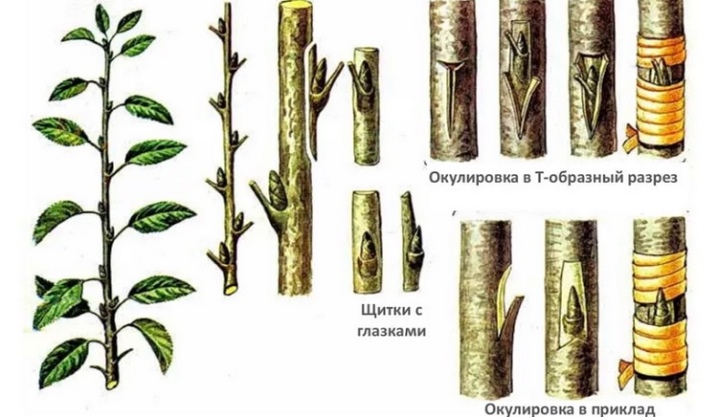
Budding
For peephole grafting, only prepared cuttings are used, so it is best carried out in the summer months. The optimal time is mid-July - early August. The budding method is divided into several types.
Sleeping eye grafting is carried out in July. In the spring, the grafted bud should already sprout. It is important to carry out the procedure on time so that the peephole has time to take root. When using a sprouting eye, the vaccination should be carried out in the spring months (during the period of swelling of the kidneys). The cut is done on the day of crossing. This method is only good for regions with warm climates.
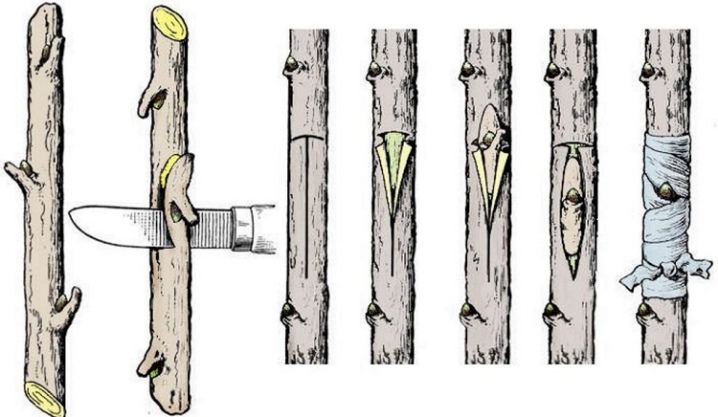
You can correctly carry out budding by adhering to the following steps.
- For the bark to separate better, the stock should be watered a week before the procedure.
- Remove dirt from the tree trunk with a damp cloth.
- On the trunk, you should choose a place that will be about 6 centimeters above the ground level. A T-shaped incision must be made on it.
- The leaves from the scion are carefully removed. After that, you need to select the formed kidney and cut it off with a special knife.
- The kidney is removed together with the adjacent tissues within a radius of one and a half centimeters. The bark with cambium should also be removed.
- On the rootstock, move the cut bark and place a shield with a kidney in the resulting incision. It is important to press it tightly, holding the petiole.
- The site where the vaccination was given is covered with polyethylene, but the kidney must remain visible.
- After a couple of weeks, green tissue should be visible on the scion, and when touched, the cutting will fall off easily. At the end of summer, the buds that sprout must be pinched during the formation of the first three true leaves.
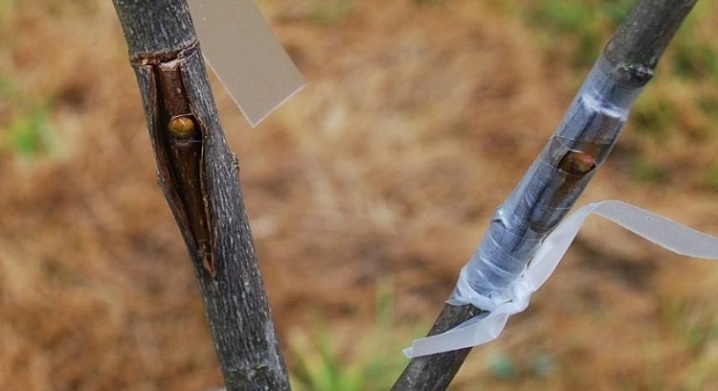
Bark grafting
From April to May, it is best to vaccinate in this way. This is due to the fact that the rootstock bark layer can be easily separated from the wood. This method consists of the following steps.
- Using a hacksaw, you need to make a saw cut, and then clean it with a knife.
- The stock should be about 4 centimeters thick.
- With a trunk thickness exceeding 2 centimeters, it is necessary to use two cuttings for grafting at once.
- A vertical incision of about three centimeters must be made on the bark layer.
- After that, it is necessary to part the edges of the bark to the sides and make a cut obliquely on the graft, on which there are at least three buds.
- The resulting stalk should be inserted into the cut so that the cut is tightly pressed against the core. In this case, it is important that a few millimeters of the cut are opened for tissue growth and early healing.
- All open sections must be wrapped with a special tape and smeared with var.
If the rootstock is thicker than the cutting itself, then grafting must be done behind the bark with a thorn. To do this, after a cut on a branch, the bark is removed by five centimeters. On the resulting cuttings, a cut is made with a ledge, which must be wrapped with special tape.
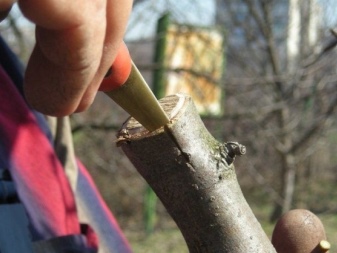
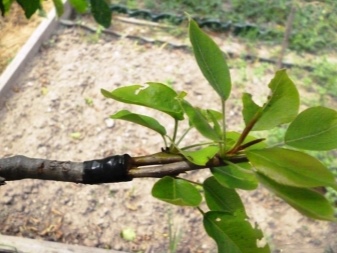
Copulation
The method is suitable for cuttings with developed buds. Copulation can be carried out both in the spring and summer months. The stalk is taken from the mother tree when the growth per year is 20 centimeters or more. Grafting in this way is most successful if the apple tree was grown from seed.For the procedure, you need to take cuttings with the same thickness. They are cut at an angle of 30 degrees. The cut pieces are applied to each other so that there is an exact match and tight pressing of the tissues. For improved copulation, which is more practiced and more reliable, it is important to prepare cuttings in advance. Store them in winter in a dark place where the temperature varies from +2 to +4 degrees. It is necessary to vaccinate only at the moment when the juice will actively move along the tree.
This method assumes slices of 3-4 diameters. You also need to cut a tongue up to 2.5 mm thick in one plane, but in the opposite direction. Finished sections and tongues are applied so that the bark coincides with the scion. The junction must be wrapped with a special tape and the stalk must be shortened by a couple of buds. On its upper cut, it is imperative to apply var.
To prevent the scorching sun from damaging the vaccination site, it must be covered with a cap. It is worth noting that this also keeps the tree free from severe frosts.
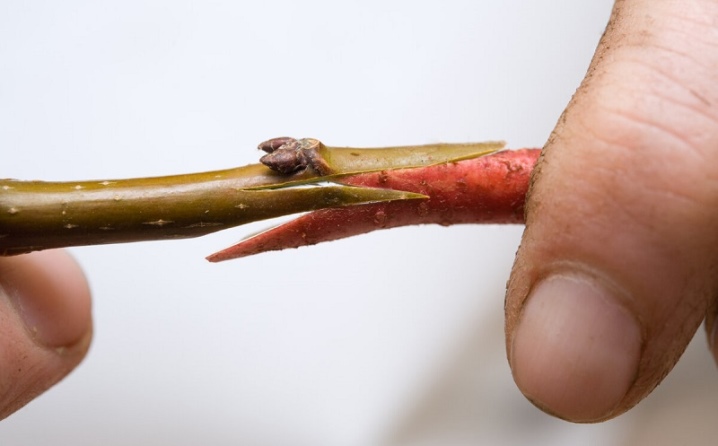
Into the cleft
This method is considered quite convenient, since it does not limit the thickness of the rootstock and scion. Pinching into the split must be carried out before the plant enters the growing season. It is optimal to do it before mid-April, when the swelling of the kidneys is just beginning. It is easy to do the vaccination with your own hands in this way if you follow certain steps.
- The preparation of the stock begins with cleaning the branch from dirt and bark that has peeled off. Then you need to take a thin wild and cut it at a height of 10 centimeters above the ground. It is imperative to clean the cut with a knife.
- The stock should be cut. A wooden wedge is inserted into the resulting gap.
- A one-year-old stalk is taken as a scion, on which there will be from three to five buds. It is necessary to cut off its lower part into a wedge.
- After that, the cutting is cleaned. It is necessary to insert into the split with the coincidence of the cambium layers on the scion and rootstock. Free space should be left a little above the splice so that the splice process works better.
In the event that the stock is thick, then two cuttings are inserted into it from opposite sides at once. At the junction points, fastening is carried out using a special tape, electrical tape or film. All places that have remained open must be greased with pitch.
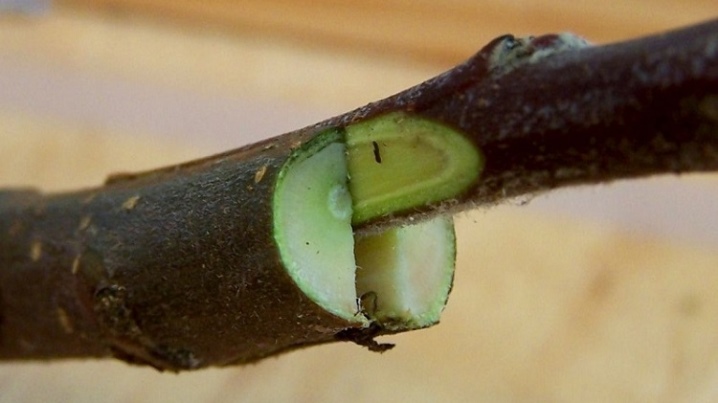
Side cut
This method of inoculation should be used if it is necessary to correct the crown with one side. Crossing in a side cut allows you to fasten the rootstock with the scion quickly and firmly enough. The timing of such an inoculation falls on both the spring and summer months. It is important that there are two buds on the rootstock cuttings.
On the rootstock, you need to make a cut obliquely, the length will be equal to three diameters of the cutting. In this case, the knife must be directed at an angle of 90 degrees to the axis of the stock. After turning the cutting 180 degrees, the knife is placed at an angle of 45 degrees and another cut is made. It is necessary that the cut on the rootstock and the scion coincide. The cut is inserted so that the cambia are aligned.
The grafting site must be wrapped with tape, the stalk is covered with pitch.
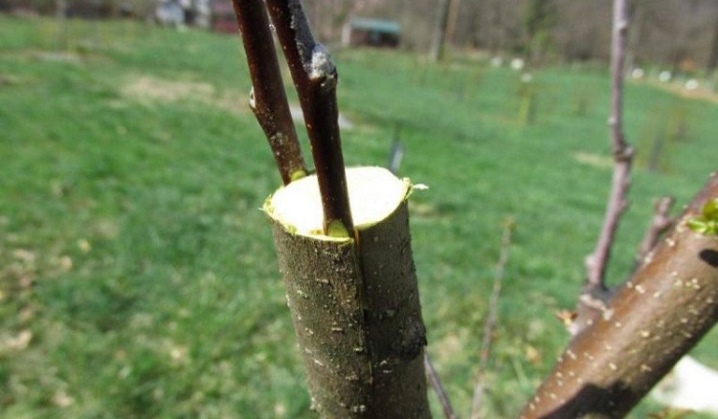
By the bridge
In this way, it is good to graft trees if ring damage to the bark was caused by rodents in winter. For this it is necessary to detach the top and bottom of the bark using grafting using several cuttings. The area that has been injured should be trimmed and cleaned to healthy layers.
From the cuttings, you need to cut off the buds, and then make holes obliquely at the ends. The finished branches are inserted with cuts behind the bark layer. The distance must be such that parts that have been injured remain intact. As a result, the bridge connects the bark in the form of an even arc. The grafting sites should be tied and wrapped, the damage should be lubricated with garden varnish, and also covered with moistened moss and burlap.
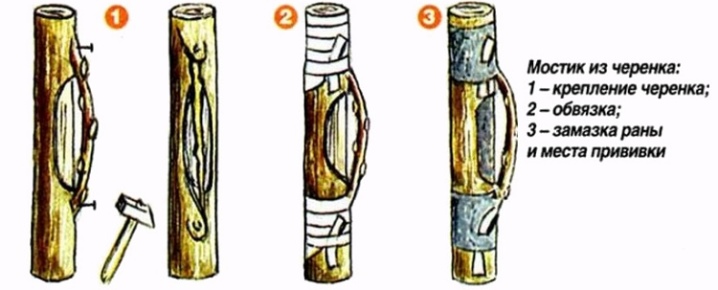
On a columnar apple tree
If the dwarf apple tree is damaged, then a forced vaccination is done on it.It allows you to restore the lost part of the tree. For this, a broken branch is replaced by a scion, which must be strong and healthy. The method is very successful and allows the crown of the plant to leave its shape unchanged.
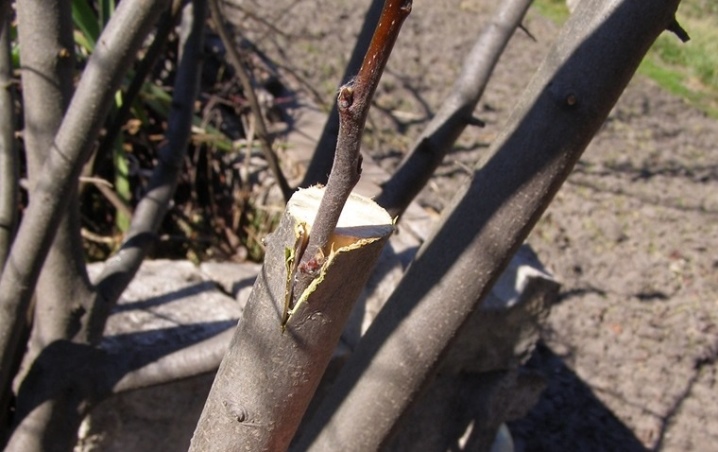
Into the wild
It is easy to vaccinate wild apple trees due to their high immunity. Moreover, you can grow such a tree from seeds or uproot a process in the forest. This method is especially useful for low yielding crops. However, it requires increased attention to the grafted tree. For example, in extreme heat or cold, it must be covered.
It should also be borne in mind that fruits do not always improve their taste.
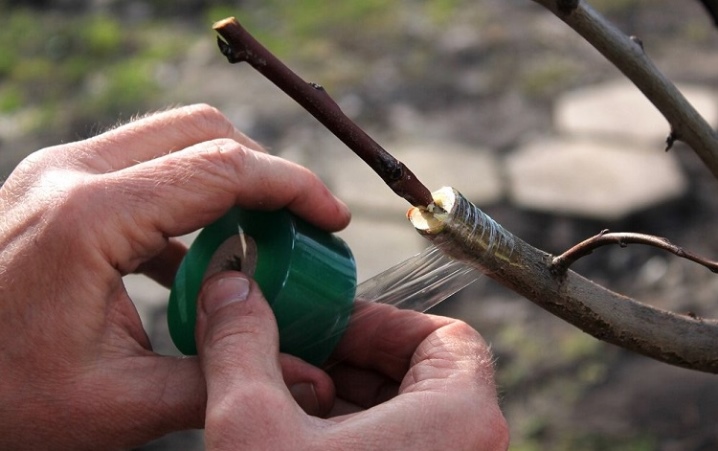






The comment was sent successfully.